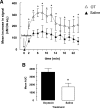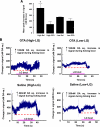Oxytocin-dopamine interactions mediate variations in maternal behavior in the rat
- PMID: 20228171
- PMCID: PMC2869254
- DOI: 10.1210/en.2009-1271
Oxytocin-dopamine interactions mediate variations in maternal behavior in the rat
Abstract
Variations in maternal behavior among lactating rats associate with differences in estrogen-oxytocin interactions in the medial preoptic area (mPOA) and in dopamine levels in the nucleus accumbens (nAcc). Thus, stable, individual differences in pup licking/grooming (LG) are abolished by oxytocin receptor blockade or treatments that eliminate differences in the nAcc dopamine signal. We provide novel evidence for a direct effect of oxytocin at the level of the ventral tegmental area (VTA) in the regulation of nAcc dopamine levels. Mothers that exhibit consistently increased pup LG (i.e. high LG mothers) by comparison with low LG mothers show increased oxytocin expression in the mPOA and the paraventricular nucleus of the hypothalamus and increased projections of oxytocin-positive cells from both mPOA and paraventricular nucleus of the hypothalamus to the VTA. Direct infusion of oxytocin into the VTA increased the dopamine signal in the nAcc. Finally, high compared with low LG mothers show greater increases in dopamine signal in the nAcc during bouts of pup LG, and this difference is abolished with infusions of an oxytocin receptor antagonist directly into the VTA. These studies reveal a direct effect of oxytocin on dopamine release within the mesocorticolimbic dopamine system and are consistent with previous reports of oxytocin-dopamine interactions in the establishment and maintenance of social bonds.
Figures





Comment in
-
Baby love? Oxytocin-dopamine interactions in mother-infant bonding.Endocrinology. 2010 May;151(5):1978-80. doi: 10.1210/en.2010-0259. Endocrinology. 2010. PMID: 20410209 No abstract available.
References
-
- Moltz H, Lubin M, Leon M, Numan M 1970 Hormonal induction of maternal behavior in the ovariectomized nulliparous rat. Physiol Behav 5:1371–1377 - PubMed
-
- Rosenblatt JS 1994 Psychobiology of maternal behavior: contribution to the clinical understanding of maternal behavior among humans. Acta Paediatr Suppl 397:3–8 - PubMed
-
- Bridges RS 1996 Biochemical basis of parental behavior in the rat. Adv Study Behav 25:215–242
-
- Fleming AS, O'Day DH, Kraemer GW 1999 Neurobiology of mother-infant interactions: experience and central nervous system plasticity across development and generations. Neurosci Biobehav Rev 23:673–685 - PubMed
-
- Giordano AL, Siegel HI, Rosenblatt JS 1989 Nuclear estrogen receptor binding in the preoptic area and hypothalamus of pregnancy-terminated rats: correlation with the onset of maternal behavior. Neuroendocrinology 50:248–258 - PubMed

